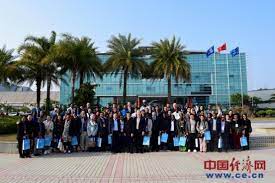Pakistani officials learn poverty alleviation techniques from China

China Economic Net
Beijing: China’s Ministry of Commerce welcomed the first batch of information officials who participated in the 14-day seminar on China’s poverty alleviation practices under the Global Development Initiative.
The seminar, hosted by the Academy for International Business Officials (AIBO), Ministry of Commerce, China, is one of the five seminars that took place from February 22 to March 7, wherein a total of nearly 200 officials from 27 countries across the globe took part.
Pizwak Imtiaz Section Officer (F&A), Ministry of Poverty Alleviation and Social Safety (PA&SS), who was among the participants, said that another official from the Ministry of Economic Affairs, Government of Pakistan also attended the seminar on International Cooperation and Trade.
“The seminar included a 4-day trip to the coastal city of Fuzhou, Fujian, during which we visited the Juncao Technology Research Center at Fujian Agriculture and Forestry University,” she told China Economic Net (CEN), adding, Juncao Technology uses wild grass for the cultivation of medicinal mushrooms that has transformed the production of high-yield mushrooms since 1989 and helped ecological protection by preventing soil erosion and desertification.
The technology is currently under experiment in Gwadar Port in Pakistan, she said.
In addition, the visit included a trip to the Fuyao Glass factory which produces world-quality automobile glass for key manufacturers across the globe, creating jobs, infrastructure and employment opportunities for locals since 1987.
“I was impressed by the village businesses that are modern, digitized and profit-based. Whether agro-based or industry-reliant, there has been a targeted shift towards digital systems empowered by locals who are effectively trained in marketing, media, and enterprise development. Additionally, the online and infrastructural value chains created across struggling regions in the northern and western provinces of China have allowed these regions to be part of the country’s growth rather than hurdles,” she recalled.
“All tiers of government local institutions and businesses are synergized to work towards the common goal. This system of centralized planning but decentralized and coordinated implementation provided an excellent opportunity for locals to have specialized solutions to their problems. This is something that developing nations struggle with, owing to there being different institutions working often with lack of coordination,” she observed.
She said that the poverty rate in Pakistan had declined from 57.9% in 1998 to 24.3% in 2015, but it remains unacceptably high as of today. A much higher percentage of the population faces non-monetary deprivations.
The prevalence of multidimensional poverty is 38.4% (including education, health and living standards). Rural multidimensional poverty headcount is as high as 55%, in contrast to urban areas where only 9% of the urban population is multi-dimensionally poor. Furthermore, Pakistan faces challenges of food insecurity amid various climatic challenges; 36 percent of the population is currently food insecure.
In a joint effort, PA&SS Pakistan and the Ministry of Commerce, China signed an MoU on Cooperation in the Field of Poverty Alleviation in December 2021. In August 2022, the two Ministries jointly organised the China-Pakistan Forum on ‘Commerce-Driven Poverty Reduction and Social Development’.
“The seminar on China’s poverty alleviation practices under the GDI is the first in-person event conducted, and hopefully will lead to many other meaningful areas of collaboration,” she said.





